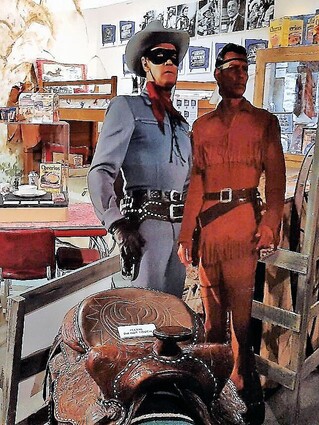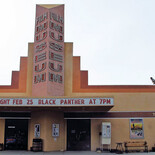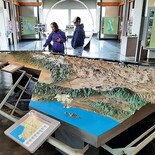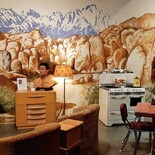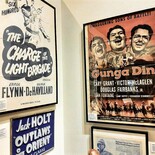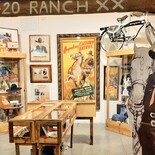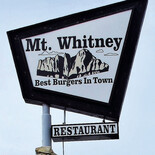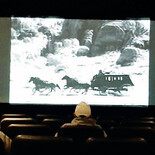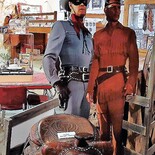Lone Pine Western Film Museum
Day Trippin' with Mel
March 4, 2023

Mel Makaw.
A 15-minute documentary in the museum tells the history of Hollywood film making in the Alabama Hills.
I've been through Lone Pine a few times on the 395 heading for somewhere else, but I hadn't yet been to Lone Pine as a destination until a couple of weeks ago. One Friday morning, Leila, one of my day trippin' pals, and I headed up north to check out Lone Pine, specifically with the film museum in mind.
It was a gorgeous day for the drive up along the Southern Sierras; Red Rocks State Park was as stunning as ever to pass through, and we also drove by a large area of lava beds further north. What used to be a lake in Owens Valley was barely wet, but all along the way we saw plenty of snow on the mountains, more so as we got closer to Lone Pine and the Mt Whitney area. Part of that highway is designated an Eastern Sierras Scenic Byway, and I can see why.
Closer to Lone Pine, the area west of the highway is called the Alabama Hills, a formation of rounded rock and eroded hills set between the jagged Sierra Nevada's and the lesser-known Inyo Mountains. The hills consist of nearly 30,000 acres of public lands managed by the Bureau of Land Management.
Because of their geology, ruggedness, and proximity to the film industry in Los Angeles, the Alabama Hills have long been a favorite location for making movies and television shows, especially westerns. It's hard to imagine anyone who hasn't seen at least one show that's been filmed in the Hills. (I believe I've seen hundreds from when I was a kid and used to watch all my favorites on TV on Saturday mornings.)
Before we got into town for lunch at the Mt Whitney Restaurant (best burgers in town, they say, and I have to agree they were pretty darned good!) and a trip to the museum, we stopped at the Visitor Center at the junction of the 395 and the 136 turn off to Death Valley. I'd stopped there before and knew it to be an interesting place, but I was impressed with how it has been rebuilt and grown over the years. Now with a large gift shop and a much more modern and informative section on the history of the area, most noticeable the Owens Valley and its importance to Los Angeles, it's well worth a stop.

In Lone Pine, after lunch we made our way back to our ultimate goal, the Museum of Western Film History. It looks simple enough from the outside that it is quite a pleasant surprise when we got inside and realized how very big it is.
The museum is chock full of movie and television posters and accoutrements from the past, and a few from more modern times as well. It also has a huge collection of vintage and modern film-making equipment, vehicles and wagons, props and costumes. Several life-sized cutouts offer photo opportunities with your favorite cowboy; some of the featured are Roy and Dale, Lone Ranger and Tonto, Tex Ritter, Gene Autry, Audie Murphy and Randolph Scott, Steve McQueen, and so many more.
The museum also features a 15-minute documentary in its 85-seat screening room, titled Lone Pine, Where the Real West Becomes the Reel West, well worth the time to take it in.
If you go, the easiest route is to take the 58 to Mojave, then north on the 14 (toward Bishop), which becomes the 395, and on up to Lone Pine. Alexa tells me that Lone Pine is about 100 miles from Tehachapi as the crow flies, and I found it to be about 140 miles as the car drives. We got there in about two and a half hours.
The Visitor Center is on the very south edge of Lone Pine, and the film museum is about a mile further into town. Just beyond the museum are restaurants, gas stations, inns and touristy shops, and a large public park, all accessible from the 395. It would be fun to go and stay the night and really explore the little town.
The Museum of Western Film History is open seven days a week (except major holidays); winter hours (November through April) are Sundays 10 a.m. to 4 p.m. and other days 10 a.m. to 5 p.m .; during the summer (May through October) they stay open an hour later on weekdays and Saturdays.
Visiting the gift shop and restrooms in the museum is free; a donation of $5 per person is requested to visit the museum part, which I thought was well worth it.
© 2023 Mel Makaw. Mel, Tehachapi writer/photographer and avid day tripper welcomes your questions, comments, and suggestions at morningland@msn.com.




